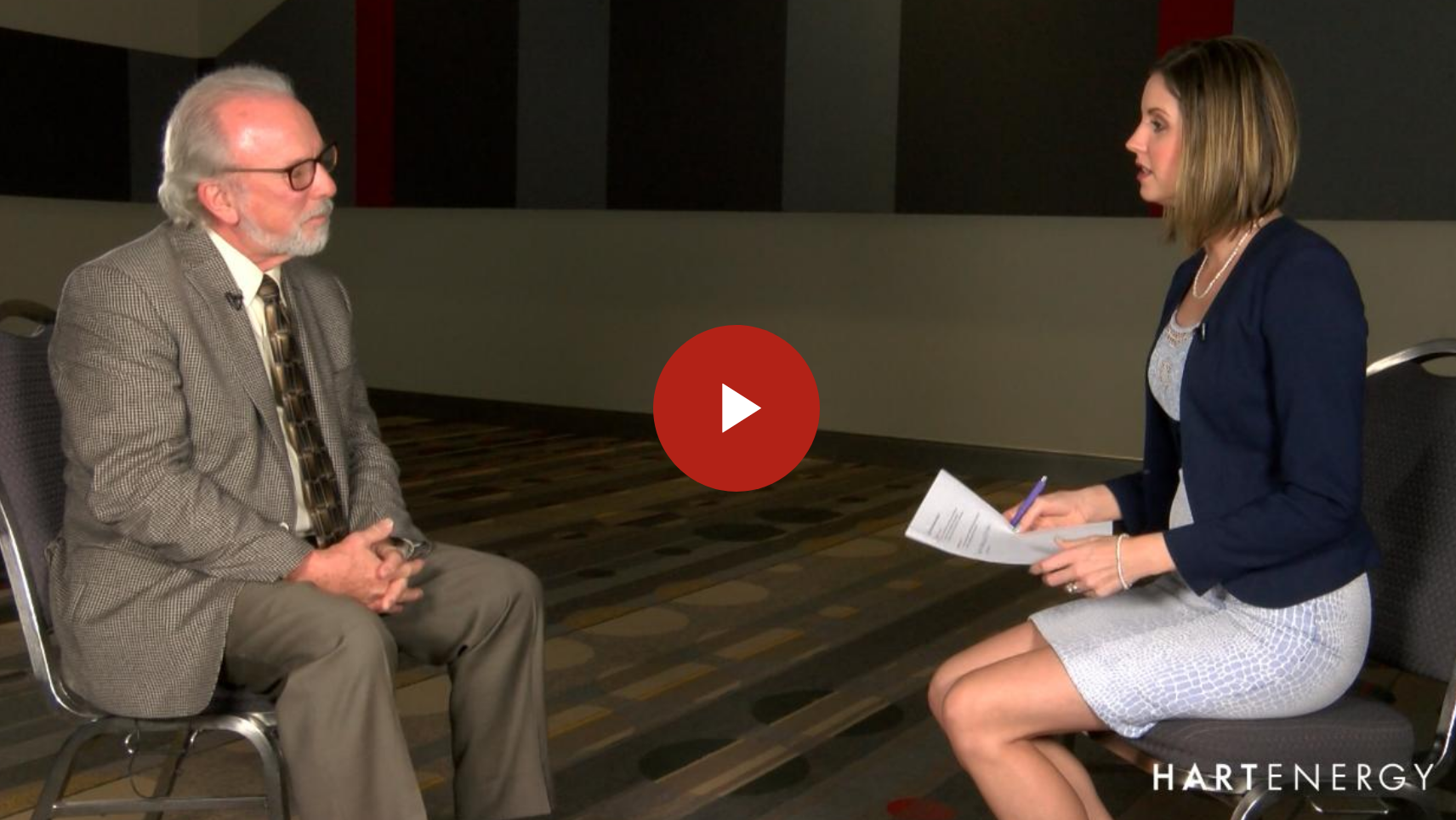
MicroSeismic Inc.'s President and CEO, Peter Duncan, speaks at the Well Interference Forum at DUG Eagle Ford in San Antonio. (Source: Steve Toon, Hart Energy)
SAN ANTONIO—With maturing U.S. unconventional basins such as the Permian and Eagle Ford in Texas rolling into full field development mode, questions are being asked about just how much industry truly knows about what it happening below ground following the completion of a horizontal well.
Simple formulas would dictate a certain land parcel with wells spaced at a certain distance would yield a specific potential for produced volumes; however, operators trying to get the most out of their acreage are finding some of their spacing recipes are too aggressive—and the wells are actually interacting with each other in negative ways.
“Even though we’ve drilled thousands of wells, the large resource area, the heterogeneous distribution of the rock properties, the large range of fluid types, the continuous evolving of completion designs…we don’t know what we’re doing,” Peter Duncan, president and CEO of MicroSeismic Inc., concluded to attendees at the recent Hart Energy Well Interference Forum, part of the DUG Eagle Ford Conference and Exhibition in San Antonio.
“We really don’t know yet what we’re doing, and isn’t that a surprise. We see it every day. They (operators) are having trouble,” he continued. “They are having to restate reserves because they’ve found that the wells have gotten too close. They are interfering with each other. They are not delivering what was expected. Concho, earlier this summer, realized a 20% drop in their stock value when they reported that the wells being closer together, perhaps that was the problem, are causing the production from those wells to be much less than they had reported. We definitely have a problem.”

The biggest issue is that what is termed a ‘frac hit’—the mechanical interference between the wells when you frac them—can cause damage or change in the reservoir pattern between wells. That can cause production interference—two wells drawing from the same reservoir could start robbing reserves from each other.
Frac hits are not uncommon. They are caused when an infill or child well is drilled and fracked nearby the primary or parent well. That initial well has already begun drawing down pressure in the reservoir. Once the infill well is fracked, those fissures tend to migrate towards the path of least resistance. In this case, the pressure sink caused by the primary well. The severity of the frac hit can vary from just a slight change in primary well pressure that could cause a temporary dip in production all the way to proppant invasion and well failure.
“The results of the frac hits in the cases where you’re not getting any fluid or proppant in the parent well, you may have a temporary loss of production,” Duncan said. “Generally it is found that if you haven’t caused fluid to go into the parent well it may reduce production for a while, but then come back. You may have permanent loss of production if in fact you have exchanged fluids with the parent well…maybe as much as 20% to 40% of the EUR of the parent well.
“On the other side, if you have robbed the child well’s treatment into the parent well, if you’ve stolen it, then you might not have the development of the SRV (stimulated rock volume) around the child well and may end up with child wells producing a 20% or greater reduction to the parent well in the area. You also may end up with wellbore damage leading to the loss of the parent well. This is becoming a bigger phenomenon as our fracs get bigger and as we are putting more pressure into the reservoir.”
Operators are attempting to overcome frac hits in a number of ways including shutting in the primary well, pressuring up the primary well or abandoning it altogether. To date, pressuring up the primary well has met with success. Staging an adequate well ‘defense’ can steer the infill fractures away from the primary well thus not impacting the initial reservoir contacts and opening up different areas of the reservoir for production at the same time. Another method that has shown promise is completing the wells all at the same time using zipper fracks and offsetting clusters. This has proved effective, but expensive.
“We see these (fractures) at such distances from the parent well that there is probably no way to avoid them completely,” Duncan said. “Instead, you manage, monitor and try and minimize the effects, but then model to see what the proximity of the wells is going to do for you economically.”
Recommended Reading
Range Resources Holds Production Steady in 1Q 2024
2024-04-24 - NGLs are providing a boost for Range Resources as the company waits for natural gas demand to rebound.
Hess Midstream Increases Class A Distribution
2024-04-24 - Hess Midstream has increased its quarterly distribution per Class A share by approximately 45% since the first quarter of 2021.
Baker Hughes Awarded Saudi Pipeline Technology Contract
2024-04-23 - Baker Hughes will supply centrifugal compressors for Saudi Arabia’s new pipeline system, which aims to increase gas distribution across the kingdom and reduce carbon emissions
PrairieSky Adds $6.4MM in Mannville Royalty Interests, Reduces Debt
2024-04-23 - PrairieSky Royalty said the acquisition was funded with excess earnings from the CA$83 million (US$60.75 million) generated from operations.
Equitrans Midstream Announces Quarterly Dividends
2024-04-23 - Equitrans' dividends will be paid on May 15 to all applicable ETRN shareholders of record at the close of business on May 7.





